
The category of Xu Mai includes five pulse patterns: Xu Mai (虚脉), Wei Mai (微脉), Xi Mai (细脉), Dai Mai (代脉), and Duan Mai (短脉), all characterized by weak pulsations.

Xu Mai (虚脉)
【Pulse Characteristics】
The pulse at the cun, guan, and chi positions is floating, large, slow, and soft, feeling empty during palpation.
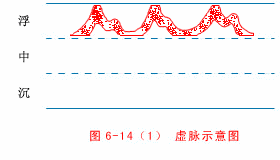
The characteristics of Xu Mai are a relaxed pulse vessel with insufficient fullness, a floating and wide appearance when lightly palpated, a slow pulsation, and a soft response, feeling empty upon pressure. Li Zhongzi in “Zhen Jia Zheng Yan” stated: “Xu combines four forms, floating, large, slow, and soft, and when palpated, it is almost imperceptible.” This succinctly summarizes the characteristics of Xu Mai.
【Common Clinical Conditions】
Often seen in deficiency syndromes, particularly Qi and Blood deficiency.
【Mechanism Analysis of Pulse Characteristics】
Blood deficiency fails to fill the pulse, while Qi deficiency cannot constrict the pulse vessel, leading to a relaxed pulse vessel; hence, it feels empty upon pressure (the empty sensation is pronounced during palpation); blood deficiency fails to contain, and Qi floats outward, resulting in a large floating pulse; Qi deficiency leads to weak pulsation and blood flow, thus the pulse is slow and soft.
Wei Mai (微脉)
【Pulse Characteristics】
The pulse is extremely fine and soft, barely perceptible, with a sensation of impending cessation during palpation.
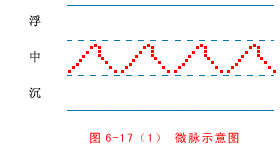
The characteristics of Wei Mai are an extremely fine pulse shape and very soft pulse strength, feeling almost imperceptible, with a vague rise and fall.
【Common Clinical Conditions】
Primarily associated with severe Yang Qi deficiency and significant Qi and Blood deficiency.
【Mechanism Analysis of Pulse Characteristics】
Ying (nutritive) blood deficiency cannot fill the pulse, resulting in an extremely fine pulse; weak Yang Qi fails to propel the pulse, leading to a very soft pulse that feels as if it is about to cease, with a vague rise and fall.
Xi Mai (细脉)
【Pulse Characteristics】
The pulse is as fine as a thread, but the response is clear.
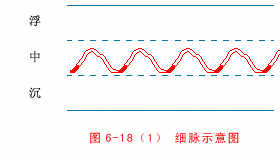
The characteristics of Xi Mai are a narrow pulse vessel, a fine pulse shape, and a clear response during palpation, though it feels like a thread.
【Common Clinical Conditions】
Often seen in Qi and Blood deficiency, dampness diseases, Yang collapse, Yin collapse, Yin deficiency, and Heart Yang deficiency (e.g., rheumatic heart disease with mitral regurgitation or aortic stenosis).
【Analysis of Clinical Pulse Characteristics】
Blood deficiency fails to fill the pulse vessel, resulting in a fine pulse; Qi deficiency leads to weak pulsation, making the pulse feel weak. Heart Yang deficiency or Yang collapse leads to insufficient blood flow, resulting in a fine and rapid pulse. Yin deficiency or Yin collapse leads to a fine and rapid pulse. Dampness causes stagnation, obstructing the pulse, leading to a fine pulse with a strong response.
Dai Mai (代脉)
【Pulse Characteristics】
The pulse has a regular pause, with a defined duration of cessation, generally longer than normal.
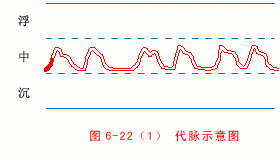
Dai Mai is characterized by a rhythmic pause in the pulse; regardless of whether the pulse is fast or slow, as long as there is a regular cessation, it is considered Dai Mai.
【Common Clinical Conditions】
Often seen in organ Qi deficiency, primarily Heart Yang and Heart Qi deficiency, Kidney Qi exhaustion, phlegm obstruction, Qi stagnation, food accumulation, and blood stasis; also seen in cases of digitalis or quinidine poisoning.
【Pathological Analysis of Pulse Characteristics】
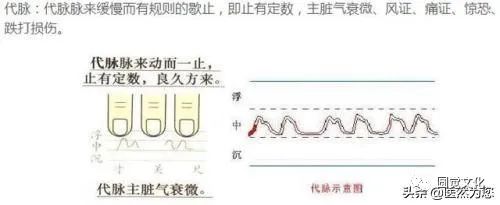
Kidney Qi exhaustion leads to insufficient propulsion, or Heart Qi and Yang deficiency result in weak pulsation, causing the pulse to intermittently stop (cessation) with a defined duration, leading to Dai Mai. Phlegm turbidity, food accumulation, Qi stagnation, and blood stasis obstruct the pulse, causing irregular flow and resulting in a pulse with regular pauses.
Digitalis, quinidine, and other drug poisoning can damage Heart Yang, affecting pulse flow, leading to regular pauses in the pulse, which can also present as Dai Mai.
Additionally, emotional tension, excitement, or fear can lead to Dai Mai, which is considered a normal phenomenon.
【Interpretation from Chinese and Western Medical Perspectives】
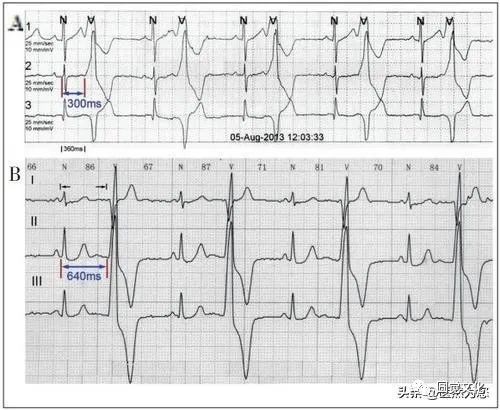
The clinical significance of Cu Mai (促脉), Jie Mai (结脉), and Dai Mai is based on the early contraction of the heart, also known as premature beats.
Premature beats are caused by ectopic pacemaker points firing impulses too early, leading to heart contractions. This can occur in patients with either sinus or ectopic rhythms; it can happen sporadically or frequently; it can occur irregularly or regularly after every one or two normal beats, forming bigeminy or trigeminy.
Irregular premature beats form Jie Mai or Cu Mai; regular premature beats form Dai Mai.
Premature beats can occur in healthy individuals, especially the elderly, often without obvious triggers, but are frequently caused by emotional excitement, mental stress, fatigue, indigestion, excessive alcohol consumption, smoking, or drinking strong tea.
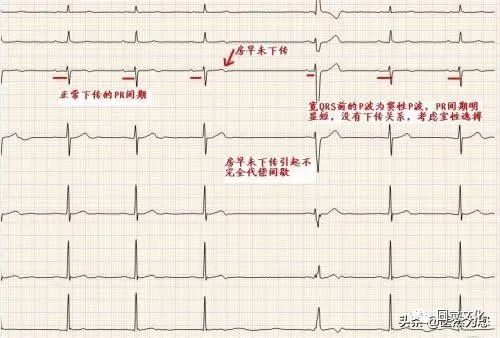
When associated with disease, it is often seen in various heart diseases, digitalis, quinidine, and other drug toxicities, hypokalemia, and direct stimulation of the heart, such as during heart surgery or catheter examinations, which can trigger premature beats.
These causes of premature beats can be either irregular or regular. There is no evidence that regular premature beats indicate a more severe condition than irregular ones. Therefore, the clinical significance of Dai Mai and Cu, Jie Mai should be considered equivalent.
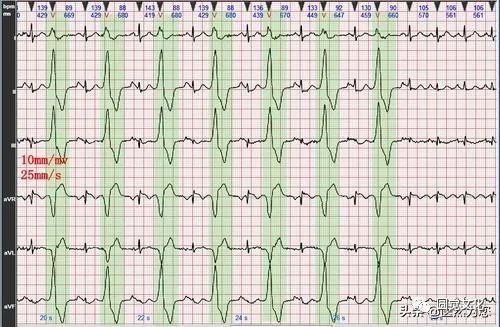
Otherwise, from a TCM perspective, it is difficult to explain the phenomenon of pulse Jie Dai, where Jie Mai and Dai Mai appear mixed; or pulse Cu Dai, where Cu Mai and Dai Mai alternate. Thus, the causes of Cu, Jie, and Dai Mai from a TCM perspective are fundamentally the same, all related to Kidney essence exhaustion, Heart Qi and Yang deficiency, Qi and Blood stagnation, and digitalis or quinidine poisoning.
Duan Mai (短脉)
【Pulse Characteristics】
The pulse at the chi and cun positions is low, while the guan position is prominent, with a noticeable pulsation.
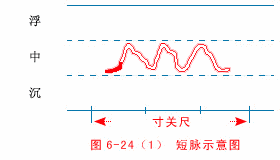
The guan position is located above the radial styloid process, making the pulse relatively superficial; thus, when palpating with the same pressure, the guan pulse is prominent while the chi and cun pulses may not be felt, leading to the sensation that only the guan pulse is detectable.
【Common Clinical Conditions】Often seen in Qi stagnation and Qi deficiency.
【Mechanism Analysis of Pulse Characteristics】
Phlegm and food accumulation, Qi stagnation, and blood stasis obstruct the Qi mechanism, causing the pulse to be short yet strong; Qi deficiency leads to weak pulsation, making it difficult for the pulse to rise, resulting in a short and weak pulse.
【Ancient Texts Discussion】
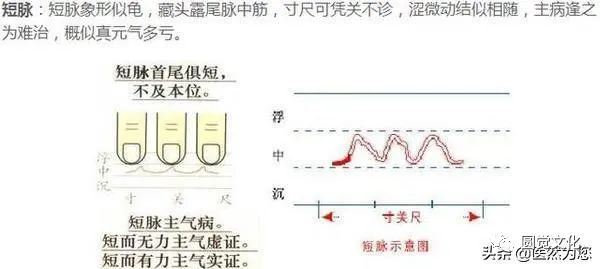
The characteristic of Duan Mai is described as “both ends are short, often only evident at the guan position, while the cun and chi positions are often not evident.” This statement must be prefaced by the fact that during floating palpation, the cun and chi positions are often not evident, and only the guan position is prominent. Due to the radial styloid process, the pulse at the guan position is relatively superficial, thus when palpated, the guan pulse is prominent, while the chi and cun pulses are often not felt. In reality, with slight pressure, the pulses at the cun and chi positions can also be detected, so the assertion that Duan Mai is “both ends are short” and “the pulse does not fill its original position” is not valid.
Li Zhongzi, a Ming dynasty physician, stated in “Zhen Jia Zheng Yan: Discussion on Pulse Diagnosis”: “The short pulse is characterized by both ends sinking while the middle is floating… The pulse is meant to be continuous; if it does not circulate, it becomes stagnant, and if it does not continue, it becomes broken. How can there be a pulse that is completely blocked? If the upper part does not connect, it indicates Yang collapse; if the lower part does not connect, it indicates Yin collapse, both of which are fatal pulses.” This statement accurately captures the essence of the pulse.
Some literature indicates that certain ancient texts require careful scrutiny and analysis.
⊙Copyright Statement: Some content is sourced from the internet, and the copyright belongs to the original author. If there is any infringement, please contact the 【Yuanjue Culture】 public account for deletion. Thank you.Yuan Jue Health Industry Welcomes Your ParticipationDaily free sharing: health management, scientific health preservation, TCM information, and knowledge popularization.


